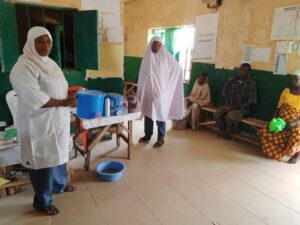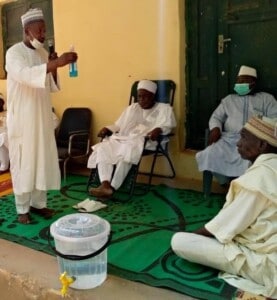Gendered Impact of COVID 19 on Women and Girls

Every pandemic, disease outbreak or crisis of any kind affects women, men, boys, girls and individuals of diverse gender identities differently. These effects are further compounded with several intersectional factors of exclusion such as disability and ethnicity. COVID-19 is no different, and undoubtedly within Kebbi State, women, girls and marginalized communities will be among the populations most affected by the pandemic.
This is in part due to gender norms, which are endemic to the State and Nigeria as a whole. Gender norms are values and practices that affect everyone at all times and in every walk of life. Due to inequitable distribution of power, wealth, opportunities and access to vital health services, COVID-19 will intensify gender issues and imbalances. There is, however, an opportunity to improve relations and responsibilities among the genders if we choose to take it.
The first step is to take a gender and inclusion sensitive lens for analyzing and understanding the impact of COVID-19 on the population of Kebbi state, and it may have differential health outcomes for vulnerable groups such as women, girls, and people with disabilities.
Some of the areas or issues around gender specific impacts of COVID-19 on women and girls include:
- The gendered distribution of work both in and out of the house and the lack of non-working time for women and girls for other purposes;
- Lack of meaningful engagement with and decision-making power of girls and women;
- Gender and inclusion barriers around access and quality of services;
- Inequitable distribution of men and women in primary health care facilities in positions with high agency and decision-making capabilities, despite the fact that most frontline healthcare workers are women;
- Increased risks of sexual and gender-based violence in the homes; and,
- The economic impacts on women and vulnerable groups
In Kebbi state, often due to the lower literacy or educational status of women and girls relative to men and boys, their access to critical health information is limited. In addition, women and girls often have limited decision-making power due to unequal power relationships in homes and communities, are financially dependent and face mobility restrictions to autonomously seek health care. According to the International Labour Organization, globally, women and girls perform on average more than three times (76%) the amount of unpaid work compared to men.[1] Particularly over time, these trends can exacerbate existing inequities and impede progress. The burdens of existing gender roles and responsibilities of women and girls in Kebbi as primary caregivers responsible for cleaning, cooking and caring for children, elders, or the sick, will undoubtedly increase as schools and childcare services have closed indefinitely and as family members become ill. Not only will this increase their existing burden of non-paid work, especially for those already also working from home, but it will also increase their susceptibility to contracting the virus. As the pandemic progresses, this existing lack of access to resources will be further compounded when further impoverished families need to make critical decisions about who receives healthcare, and too often, due to prevailing patriarchal norms, male preference, and the perceived lower social status and value of women and girls, can prevent them from accessing care.
Evidence points to an escalation of all forms of gender-based violence (GBV) during crises, including domestic violence, intimate partner violence, sexual violence and violence against children (particularly girls). Lessons from Ebola only a few years ago as well as reporting from the Chinese and European impact of the COVID-19 outbreak indicate the most harmful risk for women and girls for sexual and gender-based violence (SGBV) and intimate partner violence is during self or home quarantine. Confinement in the home along with other stressors (e.g. loss of mobility and income) related to the pandemic can increase tensions and can promote violence and harm to many women and girls who are already at risk and have no way of accessing help. Furthermore, in any crisis, and COVID-19 is no different, the risk of child early and forced marriage (CEFM) increases for girls. It is highly likely that a significant proportion of the girls now out of school will probably not return to school once communities normalize, as many will likely be married earlier than expected.
“COVID-19 lockdowns around the world have led to a rise in men’s violence in the home, as well as concerns over increases in other harmful and inequitable behaviours” Digital Activism for Engaging Men during Covid-19

Almost 70 percent of frontline health care workers are women around the world[2]. COVID -19 threatens to further strain already understaffed, poorly equipped and poorly resourced health systems in Kebbi. The insufficient quantity of essential equipment and supplies, including Personal Protective Equipment (PPE) for health workers and support staff, and other infection prevention and control (IPC) measures in many health facilities could lead to significant morbidity and mortality rates amongst the population and a health workforce already stretched thin. In addition, gender related norms and expectations add further stressors for women health workers, as they work long hours with little recourse to childcare for their children, additional domestic care work and family, and they may face additional stigma from the community due to their exposure to the virus.
What is IHP Doing to Respond to These Gaps?
To address these gender gaps, IHP is working with Gender and Youth Desk Officers (GYDOs) and service providers at the primary level of care focusing on health and hygiene and addressing GBV issues and awareness creation through remote sensitization and mentoring on GBV issues, infection prevention and control measures for Covid-19. Such measures included an emphasis on regular hand washing with soap and water by everyone in the facility to curtail new infections. Of note, hand washing corners were instituted in about 80% of IHP supported facilities in March and April 2020. Further, the use of PPE while attending to clients (namely, face masks, latex hand gloves, aprons, eye goggles, caps and rubber boots) were encouraged in addition to proper instrument decontamination in a 0.5% Chlorine solution was discussed.
IHP also aims to counteract the spread of myths and misconceptions about the virus, with knowledge gained being disseminated to women and girls across households, health posts and communities. For example, service providers and some of the Gender and Youth Desk Officers were mentored on how to prepare homemade alcohol-based sanitizer using the World Health Organization (WHO) guidelines and encouraged to institute handwashing corners in their households. They also are empowered with key information on different forms of GBV and how to identify their closest reporting contact in their community and securely send a report when violence is experienced. In conclusion, during the COVID-19 pandemic, IHP reaffirms its commitment to maintain a provision of essential (RMNCH +NM) services for women, adolescent girls and young mothers in Kebbi state. Together, we will continue to provide support to relevant health authorities, train and mentor health workers to ensure quality and accessible health services to all.
[1] https://www.ilo.org/asia/media-centre/news/WCMS_633284/lang–en/index.htm
[2] https://www.hrhresourcecenter.org/gender_stats.html